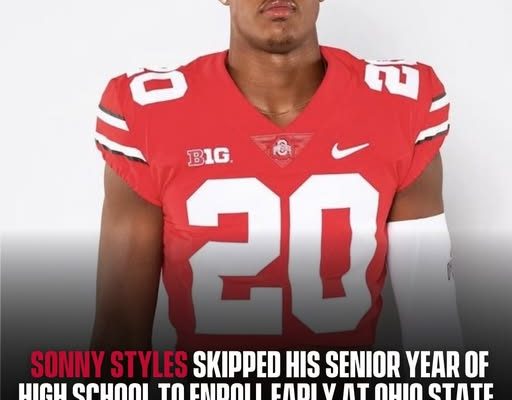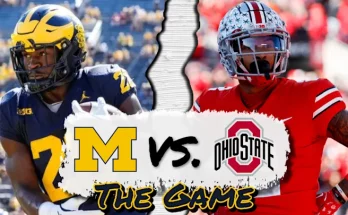Sonny Styles isn’t your typical safety, and anyone who has watched him take the field for Ohio State knows this immediately. He is a 6’4” game-changer who has redefined what it means to play the safety position in modern college football. In a sport where speed and size often appear to operate at odds with each other, Styles is one of the rare athletes who has both in abundance, creating a blend that makes him as dangerous in coverage as he is when attacking the run game. What makes his story even more remarkable is the fact that he fast-tracked his career, skipping his senior year of high school to enroll at Ohio State early, a decision that speaks volumes about his talent, maturity, and readiness to compete at the highest level. That kind of bold step is unusual, and it set the stage for a career that many believe will push him into stardom not only in college but eventually in the NFL.
When you look at Styles on paper, the physical attributes jump out before anything else. Standing at 6’4” and weighing around 220 pounds, he looks more like a linebacker than a safety. Yet, what makes him extraordinary is that he moves with the fluidity, quickness, and instincts of a defensive back. Most safeties with his kind of frame tend to be straight-line hitters, players who can intimidate in the box but struggle when asked to cover smaller, faster receivers. Styles is the opposite. His length gives him an advantage in man coverage against tight ends and taller receivers, while his footwork and top-end speed allow him to stay with quicker slot players and running backs. Quarterbacks looking across the line of scrimmage see not just a defender, but a chess piece who can line up anywhere, disguise his intentions, and create confusion before the snap. That versatility is part of what makes him so valuable and why Ohio State has been able to deploy him in so many creative ways.
Skipping a senior year of high school is not a decision made lightly, but it underscores just how advanced Styles already was as a football player and as a student of the game. Most recruits need that final year to polish their fundamentals, mature physically, and prepare for the leap into college athletics. Styles didn’t. By the time he was finishing his junior year, his combination of size, athleticism, and football IQ was already at a level where the Buckeyes’ coaching staff believed he could contribute immediately. The transition wasn’t seamless, as stepping onto a roster full of elite Division I athletes as a teenager is daunting, but Styles showed resilience and adaptability that suggested he was destined for this stage. That willingness to accelerate his development has paid off, giving him valuable game reps earlier than most players his age could dream of, and those reps are now turning into a foundation for dominance.
On the field, Styles is a nightmare for quarterbacks because he erases mismatches. In today’s game, offensive coordinators love to create mismatches by isolating safeties in coverage against quicker receivers or versatile tight ends. But Styles’ unique profile neutralizes those advantages. He is big enough to jam and run with tight ends down the seam, yet fast enough to close on receivers breaking across the middle. His wingspan allows him to disrupt passing lanes that smaller safeties simply cannot reach, and his closing speed turns what looks like an open throw into a dangerous gamble for quarterbacks. Opposing coaches have already had to adjust game plans simply to account for where he is lined up, and that kind of gravitational pull on an offense is rare for a player still so early in his college career.
It isn’t just coverage where Styles thrives, though. His instincts against the run are equally impressive. Despite being a safety, he plays with the aggression and timing of a linebacker when he comes downhill. His ability to diagnose plays, shed blockers, and finish tackles makes him a critical part of Ohio State’s run defense. Running backs who think they have a crease often find Styles crashing into the lane at full speed, using his size to finish plays violently and decisively. What separates him further is his tackling technique. While many young defensive backs rely purely on their size and athleticism, Styles tackles with precision, wrapping up securely and limiting yards after contact. That’s the kind of attention to detail that makes him not just a playmaker, but also a reliable anchor for a defense.
The leadership aspect of his game should not be overlooked, either. Coming in early meant Styles had to grow up quickly. He had to gain the respect of older teammates, some of whom had already established themselves as starters and leaders. By working hard in the weight room, showing discipline in film study, and embracing coaching, he has carved out a place not only on the field but also in the locker room. His presence has energized Ohio State’s defense, giving them someone who embodies both physical dominance and mental sharpness. That balance makes him a role model for younger players and a trusted weapon for the coaching staff.
The safety position has evolved dramatically in recent years. No longer are safeties just last-line defenders; they are hybrid players asked to do everything from blitzing off the edge, to playing man coverage, to serving as pseudo-linebackers in the box. Styles represents the next generation of this evolution. He is the prototype for the kind of positionless defender every coach covets. His ability to switch between roles within a single game—or even a single series—allows Ohio State to disguise coverages, bring pressure from unexpected angles, and shut down offensive tendencies. When you have a player who can fulfill so many roles at a high level, it fundamentally changes how the rest of the defense operates. Teammates are freer to specialize, knowing that Styles can cover multiple bases at once.
For Ohio State, having Styles in the secondary is more than just a luxury—it is a necessity in the arms race of college football. As offenses become more complex, spreading the field with elite athletes at every skill position, defenses need players who can counter those threats without forcing substitutions that give the offense an edge. Styles can stay on the field regardless of the situation, meaning Ohio State doesn’t have to reveal its intentions by swapping personnel. That kind of flexibility cannot be overstated in a game increasingly dictated by tempo and unpredictability.
The future for Styles looks bright, and while his college career is still in the making, NFL scouts are already circling his name. The professional game craves versatile defenders who can cover ground and punish ball carriers, and Styles fits that mold perfectly. His size will allow him to handle bigger tight ends and running backs in the pros, while his speed ensures he won’t be a liability against faster receivers. Add in his advanced instincts and the early experience he’s already gaining at Ohio State, and it’s clear he has the potential to be a first-round pick when his time comes. Of course, there are always areas for improvement—fine-tuning coverage techniques, continuing to polish his footwork, and building consistency in reading offenses—but those are refinements rather than fundamental flaws.
It’s also important to note that Styles’ decision to skip his senior year of high school carries symbolic weight. It shows that he’s never been afraid to challenge himself, to push beyond what’s comfortable in pursuit of growth. That mindset, combined with his natural gifts, is what separates good players from great ones. Many athletes with physical tools as rare as his never maximize them because they lack the discipline or willingness to take risks. Styles is the opposite: he thrives on the challenge and seems eager to embrace the pressure that comes with being seen as the next big thing.
Ultimately, Sonny Styles is more than just another talented Ohio State safety. He is redefining what the position looks like at the college level and perhaps setting the standard for years to come. His presence forces opponents to rethink their strategies, his versatility elevates the entire defense, and his maturity ensures that his trajectory is still pointed upward. For fans, he represents the excitement of watching a player who can take over a game from the defensive side of the ball, something that is increasingly rare in today’s offense-heavy landscape. For opponents, he is a reminder that no matter how well you prepare, there are some athletes who simply cannot be schemed away.
At 6’4” with speed, instincts, and an early start on his career, Styles embodies the future of defensive football. He is the kind of athlete who bends the rules of what is expected from his position, a player who can dominate in coverage and in the run game without sacrificing one for the other. As his career continues to unfold at Ohio State, the football world will be watching closely, not just because he is a special talent, but because he represents a glimpse into the future of the sport itself.



